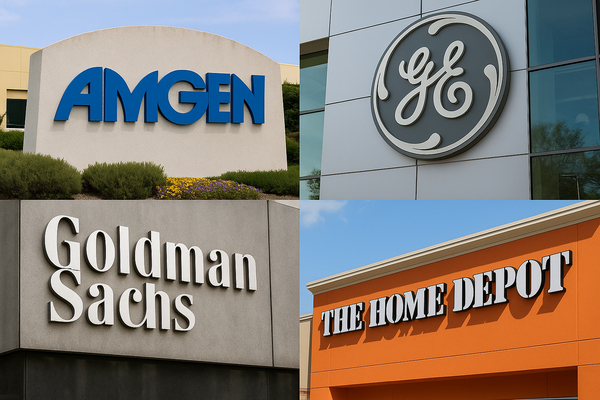
Amgen, GE, Goldman Sachs and Home Depot show mixed momentum as earnings beats, analyst conviction and operational updates reshape near-term positioning. Amgen (NASDAQ:AMGN) reported Q3 results this week and beat revenue estimates, reinforcing R&D-led growth while short-term momentum is driven by the earnings beat and pipeline updates. GE (NYSE:GE) and Goldman Sachs (NYSE:GS) carry strong analyst conviction and large YTD gains that matter for investor risk exposure in US and global industrial and financial cycles. Home Depot (NYSE:HD) faces softer price action even as commercial partnerships expand in Canada, highlighting the different growth horizons across sectors.
Amgen (NASDAQ:AMGN) — earnings beat, R&D spending frames the narrative
Amgen closed at $319.86 after reporting third-quarter results on Nov. 4. Revenue came in at $9.557 billion versus estimates near $9.146 billion, and market commentary on Nov. 5 emphasized renewed focus on R&D and a deeper pipeline. That matters now because the beat gives the stock short-term momentum and validates the company’s reinvestment thesis for longer-term revenue growth.
Technical and fundamental signals diverge. The 14-day RSI sits at 64.16 and the 50-day EMA/SMA are roughly $288, showing a recent upward trend. The 52-week range spans $253.30 to $335.88, with the stock now closer to the upper band. Analysts are constructive: an analyst score of 85.71 from 31 contributors, with mean price target $319.63 and median $321.30 (range $181.80–$425.25). Sentiment is moderate (news sentiment 45), while the letter score is B+.
Fundamentally, growth metrics read mixed but solid. Growth score is 63.72, profitability 55.99 and capital allocation 39.64%. PE (TTM) ~14.18 and payout ratio ~38% place Amgen in a value-yet-growth quadrant in health care. Short-term impact: investors will watch upcoming clinical readouts and guidance cadence; long term, R&D progress will determine whether the stock sustains its premium versus peers.
GE (NYSE:GE) — industrial comeback with outsized year-to-date gains
GE trades around $305.11, up roughly $136.52 year-to-date from $168.59 at the start of the year — an ~81% advance that repositions the name among higher-volatility industrial plays. The 14-day RSI is 63.80 and the 50-day EMA/SMA sit near $282–$281, supporting the view that recent momentum has some technical follow-through.
Analyst conviction is high: an analyst score of 100.00 based on 19 analysts, with mean price target of $349.00 and median $351.90 (range $284.04–$392.70). Fundamental profile highlights growth (growth score 89.59) and profitability strength (71.84), while leverage appears moderate (33.92%). Sector comparisons show PE (TTM) near 19.94 and revenue growth around 2.1% YoY for the most recent period reported.
Why GE matters now: its YTD surge means the stock will be sensitive to any softening in industrial demand or order cyclicality in the months ahead. Investors should weigh the company’s growth profile and the high analyst expectations against macro and supply-chain dynamics in North America, Europe and Asia.
Goldman Sachs (NYSE:GS) — market warnings and AI ties shape investor focus
Goldman Sachs trades near $793.09, about $218 higher year-to-date, reflecting strong performance across trading and investment banking cycles this year. Technicals are steady: RSI 56.94 and 50-day EMA/SMA ~761–755. The stock’s fundamental score is 66.49 with a B+ letter grade; capital allocation and growth scores are healthy, and profitability shows mid-to-high range metrics.
Recent headlines drove attention. At a Hong Kong summit, senior executives flagged the possibility of a market drawdown — a cautionary tone that has implications for risk assets and revenue volatility in trading desks. Separately, Goldman-backed initiatives surfaced in coverage: the firm’s backing of a startup that later partnered with Nvidia highlights how private investments and AI infrastructure plays can link investment banks into broader technology themes. News sentiment stands around 54, and analysts maintain a constructive stance: mean price target roughly $806.94, median $823.65 (range $614.08–$942.90).
Short-term, the market will parse indicators of trading revenue and corporate deal flow. Longer-term, exposure to private-market partnerships, technology investments and global macro cycles will determine earnings stability.
Home Depot (NYSE:HD) — soft price action, but partnership-driven incremental demand
Home Depot sits near $373.84, down modestly month-to-date and roughly 3.8% below its price at the start of the year. The 14-day RSI is 37.23 and 50-day moving averages hover near $398–402, pointing to recent weakness versus spring highs. The stock’s technical score is low (20.24) and fundamental score moderate (51.18), with a B+ letter grade.
Operational news on Nov. 4 highlighted an expanded partnership with Ecolab to roll out a commercial cleaning product line in Canada and the company’s scheduled third-quarter conference call on Nov. 18. The partnership underscores incremental revenue opportunities in the commercial channel and a product diversification angle that can bolster non-seasonal sales in North America.
With a mean analyst price target near $442 and strong overall analyst coverage, watch how margins and same-store dynamics evolve into the holiday season. The short-term story revolves around margin pressure and inventory cadence; over the medium term, commercial partnerships and broader housing/renovation demand will drive revenue trajectory.
Bottom line: disparate drivers, concentrated attention
These four large-cap names illustrate how sector-specific drivers and company-level catalysts diverge. Amgen’s recent earnings beat and R&D emphasis recalibrate expectations for health-care investors. GE’s sharp YTD move reflects industrial re-rating and elevated analyst optimism. Goldman Sachs combines market-sentiment caution with strategic technology and private-market exposure. Home Depot’s top-line initiatives point to steady, if not spectacular, growth with near-term technical pressure.
Investors and analysts should parse near-term earnings cadence, clinical and R&D news for Amgen, and macro-driven order flow for GE and Goldman Sachs, while monitoring Home Depot for margin and channel gains. The balance between technical momentum and fundamental quality will determine how each name performs across US, European and Asian markets in the coming quarters.












